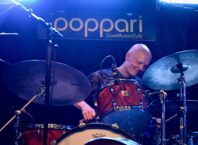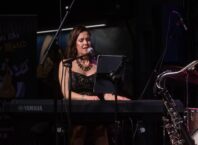Järjestyksessä toinen TUMfest soi Helsingin Savoy-teatterissa etupäässä suomalaisin ja amerikkalaisin voimin 28.-29.1.2006. Matthew Wuethrich raportoi Suomijazz.comille tapahtuman ensimmäisestä päivästä, kielenä poikkeuksellisesti englanti.
The second TUMfest came with the emphatic subtitle ”New Music!”, but if one takes ”new” to mean the latest or most current ways of making music, then this title surely misleads. Rather than offer something entirely new, the three small combos that graced the stage of Helsinki’s Savoy Theater on the two-day festival’s opening night put forward re-interpretations and re-imaginings of jazz’s improvising tropes: cerebral bebop, aggressive non-idiomatic improv, hard-swinging blues lines, free modal blowing, and blues-soaked balladry all got reworked.
The scales were tipped decidedly in favor of veteran performers. Han Bennik, Anderw Cyrille, Reggie Workman and Archie Shepp have become elders of the art, while Greg Osby and Pheeroan akLaff are established and respected performers in their own right. The youth movement was represented only in the persons of saxophonist Mikko Innanen and Estonian guitarist Jaak Sooäär. So, instead of edge- cutting and experimenting, TUMfest 06 was about consolidation, graceful showmanship, the patient confidence of experience and, above all, tradition, or more exactly the respect and refreshing of tradition. In his humorous opening speech, festival host Otto Donner referenced the growing hope that TUMfest can become a regular mid-winter event – a tradition, then, of its own.
Greg Osby and Andrew Cyrille
The New York-based duo of saxophonist Osby and percussionist Cyrille set the evening’s tone straight away. Their hour-long set was a relaxed, unhurried dialogue growing out of intricate yet swinging original compositions. Osby’s contributions, such as ”Equalateralgram” and ”Cyrille in Motion” came off as bebop slowed down and articulated, so clarified and so slowed that the idiom’s usual blur of notes became visible. The pieces exchanged frantic tempos for pulsing drum ostinatos and dexterous bursts of dashing tones were separated by unexpectedly long pauses. Such retarded time and heightened focus made the music feel entirely composed, as if Osby were coordinating his melodic clauses into mammoth sentences, dense with syntax and rich in vocabulary – At times too dense and a little too intellectual.
By contrast, Cyrille’s compositions proved to be more down-to- earth and crowd-pleasing, built as they were off terse cyclical lines. The blues-inflected riff of ”Low Blue Flame” worked as a center of gravity for both players, as they would lock in on it, e xtrapolate it, obscure it but never stray far from it. For the core theme of his solo piece ”Drum Song for Leadbelly”, Cyrille beat out on the snare rim a cocky, strutting martial drum line. Cyrille juxtaposed this theme with periodic excursions to the different parts of his drum set: the theme, then a crash of cymbals; the theme, then pounding toms; the theme, then his stool; the theme; then his chest.
When the pair finished they were gracious and forthright towards the audience, qualities they expressed in their playing as well. Their set did not challenge the ears, but it did stimulate an alternate perspective on familiar forms, as well engage in a personable manner. Most exemplary – and the most successful – of this approach, was their reading of a lesser-known Thelonious Monk piece, ”Work”. The pianist’s puzzle piece melodies lent themselves perfectly to Osby’s maze-like extensions and Cyrille’s insistent brush patterns.
Han Bennik/Mikko Innanen/Jaak Sooäär
The evening’s dignified air got its only ripples of disturbance from this meeting of three outstanding improvisers. Ironically, it was the wily veteran who wreaked the most havoc. Bennik, a lanky bald Dutchman hulking over his stripped down drum kit, made every moment of the performance a negotiation. He seemed to be constantly asking himself permission, wondering all the time: Can I do this? Can I use my foot to mute my snare? Can I bang out some chords at the piano? Can I bring my snare out from behind my kit and get real close and personal with Jaak and Mikko? What if I drag this piano bench across the stage? How would it sound if I hammer out a pulse on the stage floor to Monk’s ”Epistrophy? The answer to all of these questions was, of course, an emphatic YES.
Rather than compete with Bennik, his partners in crime followed his lead, carefully chosing when and where to propose their own directions. One never knew what sounds Sooäär would produce, as he kept shuffling his tone. It chimed like a piano, brooded like heavy organ bass, jangled like African hi-life, or simply screamed in strangled yelps. Innanen navigated his way through Bennik’s mine-field by switching between alto, soprano and baritone fluently, or sometimes blowing the former two simultaneously.
The trio’s set flowed and convulsed, first acerbic and brash then melodic and swinging, then probing and tense. They found their way into two Monk compositions, and rather than dismantle the composer’s originals, the three heightened the humor inherent in them to a manic and absurd pitch. Slight dissonances skirted but never crossed the border of rude, jaunty rhythms were jerked about but never entirely destroyed. In his drummer-cum-comedian role, Bennik extended on Monk’s own stage-wandering tendencies, never sitting in the same place for more than few minutes.
Above all, the trio’s set only highlighted the beauty and humor and energy that can arise when each impulse in improvisation remains equal, charged with the possibility of meaning, when every note, every pause, every cough, every mistake can mean everything – a whole new path – or nothing at all.
Archie Shepp Trio
The evening’s final set brought one of free jazz’s original insurgents to the stage. Archie Shepp, though, now takes the role of elder statesman, and if age has not mellowed him, it has certainly brought new sensibilities. During his six-song set he switched between tenor and saxophone sax, played the piano and crooned two ballads. His tenor tone does not sear skin and burn out eyeballs like it used to, but his soprano tone had body, shape and a touch of urgency.
Blowing winding solos on his pieces and John Coltrane’s ”Crescent”, Shepp took the long way, in no hurry to arrive anywhere and always enjoying the view. He left significant pauses and gave plenty of space for his rhythm section to stretch out. Longtime Shepp colleague Reggie Workman found a sturdy balance between the bass’s time-keeping role and its counter-pointing abilities, smoothly navigating complex meters, solid swing and diffuse lyrical passages.
With Shepp in a more reflective mood, it fell to drummer Pheeroan akLaff to play the firebrand. He moved all about his kit, punching accents and generating reams of percussive energy, but he never abdicated his role of support to the leader. AkLaff simmered just below boiling, working only the spaces others left for him.
When the trio returned for their only encore, it was Shepp who rightly took the spotlight. He did it though not with fiery politics or bombastic solos, but with his voice. He delivered a slowly unwinding love lyric, then followed it with a romantic, nostalgia-hued, but not overly sentimental, tenor serenade. It was a fitting ending to a night that was more about finding inspiration from the past rather than innovations for the future.






